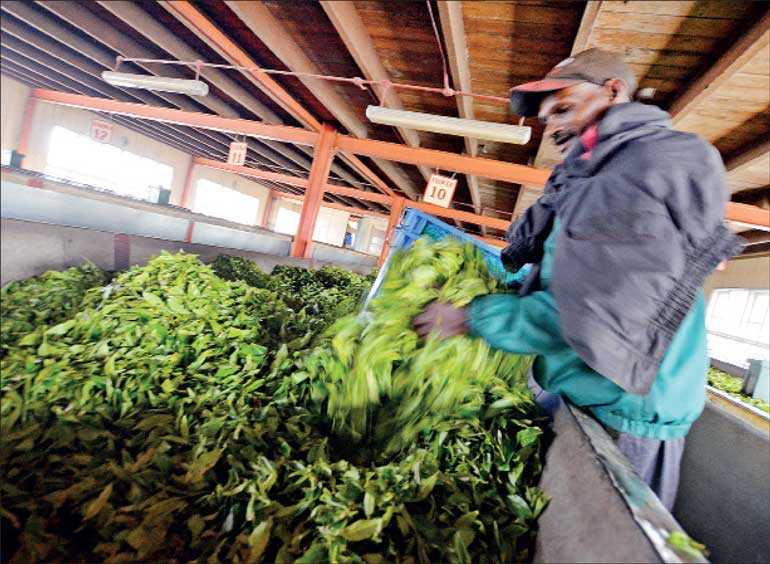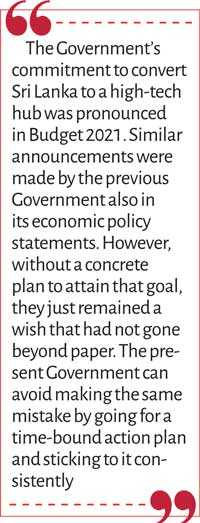Tuesday Feb 25, 2025
Tuesday Feb 25, 2025
Monday, 28 December 2020 00:30 - - {{hitsCtrl.values.hits}}

Sri Lanka with its 1% of high-tech products in manufactured exports is still in 2IR. Anyone visiting a tea factory, or a garment factory will observe that the whole manufacturing process is operated manually by using electricity-powered machines. But they are the largest export earners for the country – Pic by Shehan Gunasekara
From digital natives to global citizens
To apprise ourselves of the present state of global technology and where we are heading, I have borrowed some thoughts from a tech-Guru, ex-President of Thailand based Asian Institute of  Technology, Professor Worsak Kanok-Nukulchai. In an address delivered before the Royal Society of Thailand – that country’s counterpart of National Science Foundation in Sri Lanka – Worsak emphasised the need for converting Thais from digital natives to global citizens.
Technology, Professor Worsak Kanok-Nukulchai. In an address delivered before the Royal Society of Thailand – that country’s counterpart of National Science Foundation in Sri Lanka – Worsak emphasised the need for converting Thais from digital natives to global citizens.
That was the problem faced by Thailand with its high internet penetration. In 2020, it stood at 75% of population. But with an internet penetration of less than 30% of population, Sri Lanka’s challenge is a little different. Sri Lanka has to convert its digitally illiterates to digital natives first before thinking of making its population global citizens.
Thailand versus Sri Lanka
Both Thailand and Sri Lanka have the same economic goal today. That is to become a rich country within the next generation. Of course, Thailand with a per capita GDP of $ 7,800 in 2019 and categorised as an upper middle-income country, has started the race much ahead of Sri Lanka. In contrast, Sri Lanka is still at the threshold of joining that group with a per capita income of about $ 3,900, just a half of what Thais are earning on average. Worse, Sri Lanka was elevated to an upper middle-income country in June 2019, but it was a short-lived experience since the country was pushed back to a lower middle-income country one year later. Complicating the matter, due to economic disruption caused by COVID-19 pandemic, Sri Lanka’s situation is expected to worsen in 2020.
High-tech products in manufactured exports
Thailand is fast becoming an industrial powerhouse with about 23% of its manufactured exports representing high-tech exports in 2018 according to World Bank data. The comparable figure for Sri Lanka is a little less than 1%. Hence, the challenge for Thailand is to consolidate its power in the export market. Sri Lanka is just an infant in this trade and, therefore, has to first crawl on knees before starting to walk on its two feet. But there is a promise for Sri Lanka.
That is due to the inclusiveness of technology which the futurist Peter Diamandis has called ‘democratisation of digitisation’. Accordingly, an infant today can rise quickly on its feet and start running along with other racers without waiting for so many years to get itself ready for the race.
Technology’s exponential growth
Worsak has noted that starting from 2020, the world will move at an exponential rate from the current digital age to artificial intelligence (AI) age to reach maturity by about 2100. Technology has disrupted the world forcing people to abandon what they had been doing for ages for new things which have been more efficient and effective. Some examples used by Worsak have been the disruption of slide rule by scientific calculator, film camera by digital camera, landline telephones by smart mobile phones, manual typewriters by word processors, fossil energy by solar energy, physical banks by virtual banks, etc.
He also has referred to a mind-boggling prediction done by Ray Kurzweil of Singularity Hub about the pace of replication of human brain. AI today can replicate only the brain of a mouse. But by 2025, it will replicate a human brain and by 2055, brains of all the human beings.
Technology has not been that much of a wonder some 70 years ago. We were able to wake up from sleep peacefully in 1950 without being agitated, puzzled, or feared by the world out there. But by 2050, Worsak has concluded, it will be a completely different story. We will wake up to a world like a newly born baby helpless and not knowing what to do. Hence, Worsak has advised us to get ready now itself to face this disruptive and unknown world tomorrow.
World is now in Industry 4.0
This is an eye-opening advice for Sri Lanka. With respect to economic system, the globe has now moved to Fourth Industrial Revolution or 4IR Industry 4.0. 4IR is a term coined by Klaus Schwab, convenor of the Davos based World Economic Forum, in a book he published in 2017 under the same title. He had studied the emerging technologies in the world for about a decade and noted a significant change taking place in the technological base. By looking at the history of the industrial revolution, he had observed three previous phases.
The First Industrial Revolution or 1IR or Industry 1.0 had happened some 300 years ago. In 1IR, industrial production was mechanised basically by using steam-power or waterpower. Then, some 100 years ago, the Second Industrial Revolution or 2IR or Industry 2.0 took place by introducing electric power for mass production. The third phase of industrial revolution, code-named 3IR or Industry 3.0, began to disrupt the world some 50 years ago by introducing advanced information and communication technology or ICT and electronics for automation of industrial processes. The new products that we use on a day-to-day basis like internet, world wide web, mobile phone, Google search engine, and laptops and tablets were introduced to the world during this phase of industry.
But the world did not want to stay there. By the second decade of the 21st century, a fourth revolution, code-named 4IR or Industry 4.0, was taking shape disrupting even the new products and production processes that had been offered to us by Industry 3.0. In 4IR, we talk about Cyber Physical System, AI, machine learning, Internet of Things, robotic surgeries, etc.
Sri Lanka’s neighbours to the East are moving fast toward Industry 4.0
Some countries have moved into 4IR and many are at its doorstep. A rule of thumb to gauge whether a country has entered 4IR is to look at the high-tech component in its manufactured exports. If that component is 40% or above, that country is already in 4IR. Table 1 presents the component of high-tech products in manufactured exports of some selected countries. It is noted that countries like Malaysia, Vietnam, the Philippines, Singapore, and Hong Kong are already in 4IR. The countries like China, South Korea, and Thailand are moving fast toward that goal.
Sri Lanka should leapfrog from Industry 2.0 to Industry 4.0
Sri Lanka with its 1% of high-tech products in manufactured exports is still in 2IR. Anyone visiting a tea factory, or a garment factory will observe that the whole manufacturing process is operated manually by using electricity-powered machines. But they are the largest export earners for the country. But this should not be taken as a disappointment. That is because it gives a space of 99% for Sri Lanka to move up in the ladder to be a high-tech manufacturing nation. All it has to do is to adopt a suitable policy package consistently to take the country through that rugged path. 
But there is a challenge to be met. That challenge is since Sri Lanka is presently in 2IR, how it should leapfrog straight to 4IR bypassing 3IR. This is difficult but not impossible. In today’s advanced learning, adoption and adaptation techniques, a nation need not move ahead by following the steps one after the other. It can fast track by jumping several steps at a time. Therefore, for Sri Lanka to reach 4IR within the next decade or so is not an impossibility.
Sri Lanka’s plan to become a high-tech hub should not be a mere wish
The Government’s commitment to convert Sri Lanka to a high-tech hub was pronounced in Budget 2021. Similar announcements were made by the previous Government also in its economic policy statements. However, without a concrete plan to attain that goal, they just remained a wish that had not gone beyond paper. The present Government can avoid making the same mistake by going for a time-bound action plan and sticking to it consistently. This needs several steps to be followed.
Need for preparing a road map
Step 1 will be the preparation of a road map to convert Sri Lanka to a high-tech economy. The road map should clearly spell out the objectives, strategies, inputs to be used, key milestones and final deliverable products. Vietnam which has at present a high high-tech component in its manufactured exports had prepared such a road map in 2019 to complete the country’s transmission to 4IR by 2030 (available at: https://english.mic.gov.vn/Pages/TinTuc/139776/Proactively-participating-in-Industry-4.0.html ).
Vietnam had embarked on its journey to be a 4IR country a few years back by introducing science, technology, and creative innovation to its production structure. The new road map will have several milestones to pass in that journey. One such milestone is to improve its ranking in the Global Innovation Index or GII to be within top 40 countries by 2030. This is an eye-opener for Sri Lanka since it is ranked at 101 out of 131 countries in GII. Another milestone aspired by Vietnam is to increase the size of the digital economy to 30% of GDP, while increasing labour productivity by 7.5% per annum. It also plans to make broadband access inclusive by 2030. For that, it plans to complete the digitisation of the whole society, businesses, and the government.
Join global production sharing network
Step 2 involves joining the global supply chain or global production sharing chain by producing inputs for products that are assembled elsewhere. In today’s context, a country cannot produce a whole product and claim that it is made in that country. That is because components come from manufacturing facilities in many countries. It has been found that Apple sources components for iPhone from 43 countries, while it is finally assembled in FoxConn Factory in China. There are several manufacturing facilities in Sri Lanka that have already joined the global production sharing chain. Two noted firms are Harness Lanka at Biyagama that supplies sensors for airbags in vehicles and MAS Fabric at Thulhiriya that produces canvass for Nike shoes.
But the country needs a critical pool of such firms – a sufficiently large number of firms that can change the shape of the country – to join 4IR. Vietnam in its road map for 4IR has specifically proclaimed its intention to seamlessly integrate to the global economy. If this is to be attained, Sri Lanka should switch from the present domestic economy based economic growth to international economy based economic growth strategies.
Acquisition of technology
Step 3 involves strategies for acquiring technology immediately for use by the country’s manufacturing outfits. One way to do is to get technologies already developed elsewhere in the globe. They could be automatically acquired by attracting foreign direct investments or FDIs with a high-tech component. This was the strategy adopted by South Korea and Singapore in their initial phase of economic development and the strategy presently being pursued by Vietnam. In early 1980s, Sri Lanka got such technology for its apparel industry through FDIs. Today, garments are no more fashionable and, hence, technology drive should be for high-tech products.
The need for R&D and marketing
Step 4 requires Sri Lanka to develop its own technology in the medium to long-run. This requires Sri Lanka to invest a greater portion of its national income in research and development or R&D. According to World Bank data, Sri Lanka spends only 0,1% of GDP on R&D. This is much lower even by South Asian standards where on average, 0.65 of GDP is spent on R&D. This expenditure need not necessarily be incurred by the government. As it has happened in Japan, South Korea, Singapore and Hong Kong, private companies too should participate in R&D drive. Once new inventions are made through R&D, such inventions should be properly marketed to enable prospective entrepreneurs to produce them commercially. Austrian-American economist Joseph Schumpeter named this process as innovation.
Convert STEM to STEAM
Step 5 is about developing the country’s thinking, inventing and innovative power through a proper system of education. Traditionally, it has been emphasised that education should cover science, technology, engineering, and mathematics, abbreviated as STEM. But to create a creative thing, it is essential that inventors should possess a creative mind too. This comes from creative Art. When creative Art is added to STEM, it will become STEAM. The policy of the Government should be to change the education, learning, training, and systems to reflect STEAM.
Rebranding NSF as nSTEF
I must mention a word about National Science Foundation or NSF too. It was created in 1969 as the apex body in Sri Lanka to promote science in the country. At that time, science included every other branch and therefore NSF properly represented what it was meant for. Today, science has branched out into several key disciplines like technology and engineering. Science and Technology produce new ideas at both basic and applied research level. It is engineering that converts those new ideas into concrete products. Hence, to represent NSF’s vision and mission properly, as suggested by Product Design Engineer Thilak Diassanayake, NSF should be rebranded as National Science, Technology, and Engineering Foundation. Going by modern trend digitalising nomenclature, it can be code-named nSTEF. It can be pronounced as ENSTEF.
Follow an ‘announce and implement’ policy
These five steps are the minimum tasks which the Government should accomplish to accelerate Sri Lanka’s drive towards a high-tech nation. People today are impatient because the country remains an emerging nation forever. Hence, the Government cannot pursue ‘an announce and forget’ policy. It should announce the policy but should not allow it to be only on paper. It should therefore be an ‘announce and implement’ policy for attaining the best results for the country.
(The writer, a former Deputy Governor of the Central Bank of Sri Lanka, can be reached at [email protected].)
Discover Kapruka, the leading online shopping platform in Sri Lanka, where you can conveniently send Gifts and Flowers to your loved ones for any event including Valentine ’s Day. Explore a wide range of popular Shopping Categories on Kapruka, including Toys, Groceries, Electronics, Birthday Cakes, Fruits, Chocolates, Flower Bouquets, Clothing, Watches, Lingerie, Gift Sets and Jewellery. Also if you’re interested in selling with Kapruka, Partner Central by Kapruka is the best solution to start with. Moreover, through Kapruka Global Shop, you can also enjoy the convenience of purchasing products from renowned platforms like Amazon and eBay and have them delivered to Sri Lanka.
Discover Kapruka, the leading online shopping platform in Sri Lanka, where you can conveniently send Gifts and Flowers to your loved ones for any event including Valentine ’s Day. Explore a wide range of popular Shopping Categories on Kapruka, including Toys, Groceries, Electronics, Birthday Cakes, Fruits, Chocolates, Flower Bouquets, Clothing, Watches, Lingerie, Gift Sets and Jewellery. Also if you’re interested in selling with Kapruka, Partner Central by Kapruka is the best solution to start with. Moreover, through Kapruka Global Shop, you can also enjoy the convenience of purchasing products from renowned platforms like Amazon and eBay and have them delivered to Sri Lanka.